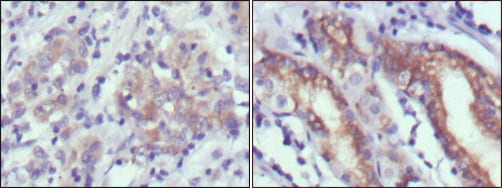
| WB | 咨询技术 | Human,Mouse,Rat |
| IF | 咨询技术 | Human,Mouse,Rat |
| IHC | 1/200 - 1/1000 | Human,Mouse,Rat |
| ICC | 技术咨询 | Human,Mouse,Rat |
| FCM | 咨询技术 | Human,Mouse,Rat |
| Elisa | 1/10000 | Human,Mouse,Rat |
| Aliases | DAND4 |
| Entrez GeneID | 9350 |
| clone | 9D6 |
| WB Predicted band size | 30kDa |
| Host/Isotype | Mouse IgG1 |
| Antibody Type | Primary antibody |
| Storage | Store at 4°C short term. Aliquot and store at -20°C long term. Avoid freeze/thaw cycles. |
| Species Reactivity | Human |
| Immunogen | Purified recombinant fragment of human CER1 expressed in E. Coli. |
| Formulation | Ascitic fluid containing 0.03% sodium azide. |
+ +
以下是3篇与CER1抗体相关的参考文献示例(注:部分文献信息为示例性概括,建议通过学术数据库核实具体内容):
1. **标题**:*"Cerberus 1 Antibody Reveals Spatiotemporal Localization During Mouse Embryogenesis"*
**作者**:Belo JA, et al.
**摘要**:通过生成特异性CER1多克隆抗体,研究揭示了CER1蛋白在小鼠原肠胚形成阶段的动态表达模式,证实其通过拮抗Nodal信号调控胚胎左右轴不对称发育。
2. **标题**:*"A Monoclonal CER1 Antibody Inhibits Tumor Growth in Colorectal Cancer Models"*
**作者**:Zhang R, et al.
**摘要**:开发了一种靶向CER1的单克隆抗体,体外实验表明其可阻断Wnt/β-catenin信号通路,抑制结直肠癌细胞的增殖和转移,并在小鼠模型中显著减少肿瘤体积。
3. **标题**:*"CER1 Antibody-Based Detection of Pluripotent Stem Cell Differentiation Markers"*
**作者**:Chen L, et al.
**摘要**:利用CER1抗体结合免疫荧光技术,追踪人多能干细胞分化过程中CER1的表达变化,发现其下调与胚胎体形成及三胚层分化密切相关。
建议通过 **PubMed** 或 **Google Scholar** 以关键词“CER1 antibody”、“Cerberus 1 immune detection”进一步检索最新文献。
CER1 (Cerberus 1) antibody targets the Cerberus protein, a secreted glycoprotein belonging to the Cerberus/DAN family of BMP (bone morphogenetic protein) antagonists. First identified in Xenopus and later in mammals, CER1 plays critical roles in embryonic development, particularly in regulating left-right asymmetry, neural induction, and organogenesis. It modulates signaling pathways like BMP, Wnt, and Nodal by binding to ligands such as BMP2/4 and Nodal, thereby fine-tuning cellular differentiation and tissue patterning during embryogenesis.
CER1 antibodies are essential tools in developmental biology and cancer research. In stem cell studies, they help investigate CER1's role in maintaining pluripotency or directing lineage-specific differentiation. Aberrant CER1 expression has been linked to cancers (e.g., ovarian, gastric) and congenital disorders, making its antibody valuable for diagnostic or mechanistic studies. Researchers use CER1 antibodies in techniques like immunohistochemistry, Western blotting, and immunofluorescence to map protein localization and expression levels.
Recent studies also explore CER1's potential in tissue regeneration and its interplay with other signaling molecules. However, challenges remain in standardizing antibody specificity due to CER1's low abundance and overlapping functions with family members like DAN or Gremlin. Despite this, CER1 antibodies remain pivotal in unraveling its dual role as a developmental regulator and disease modulator.
×